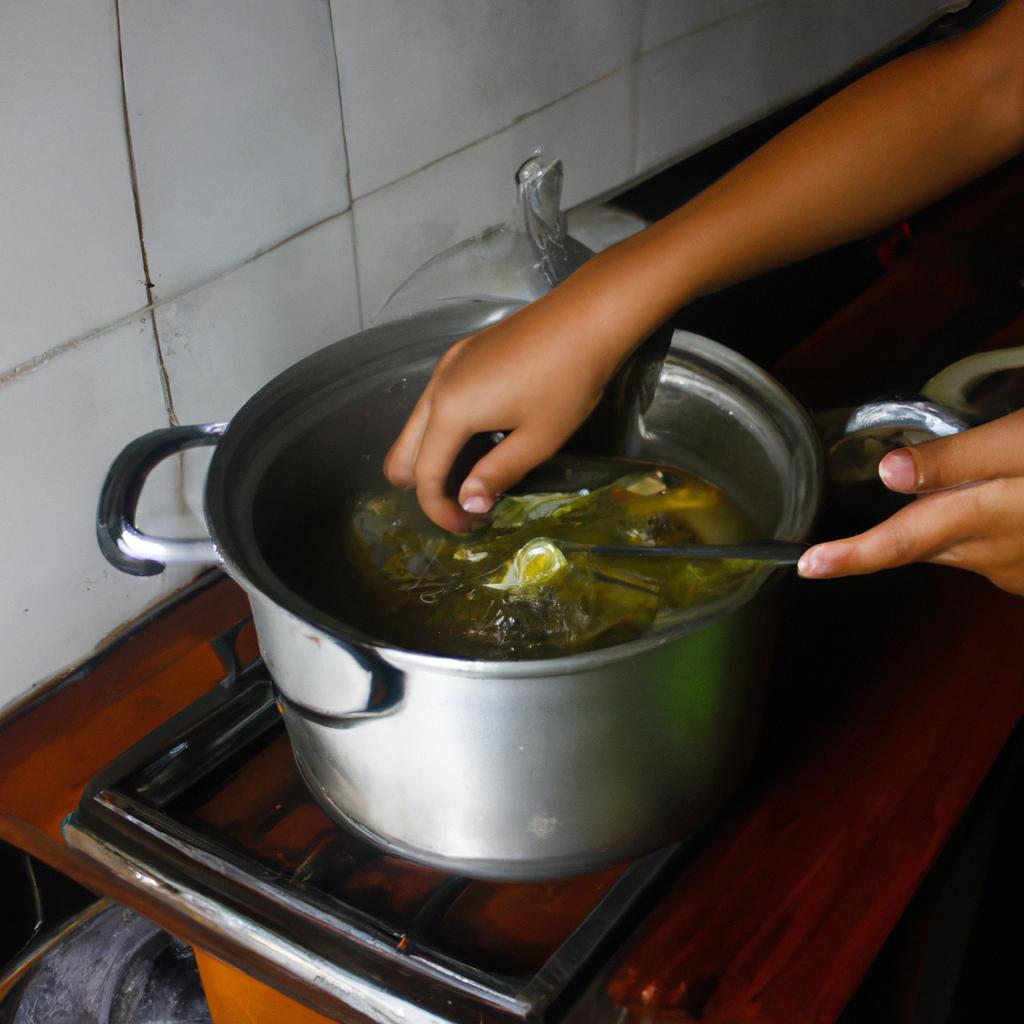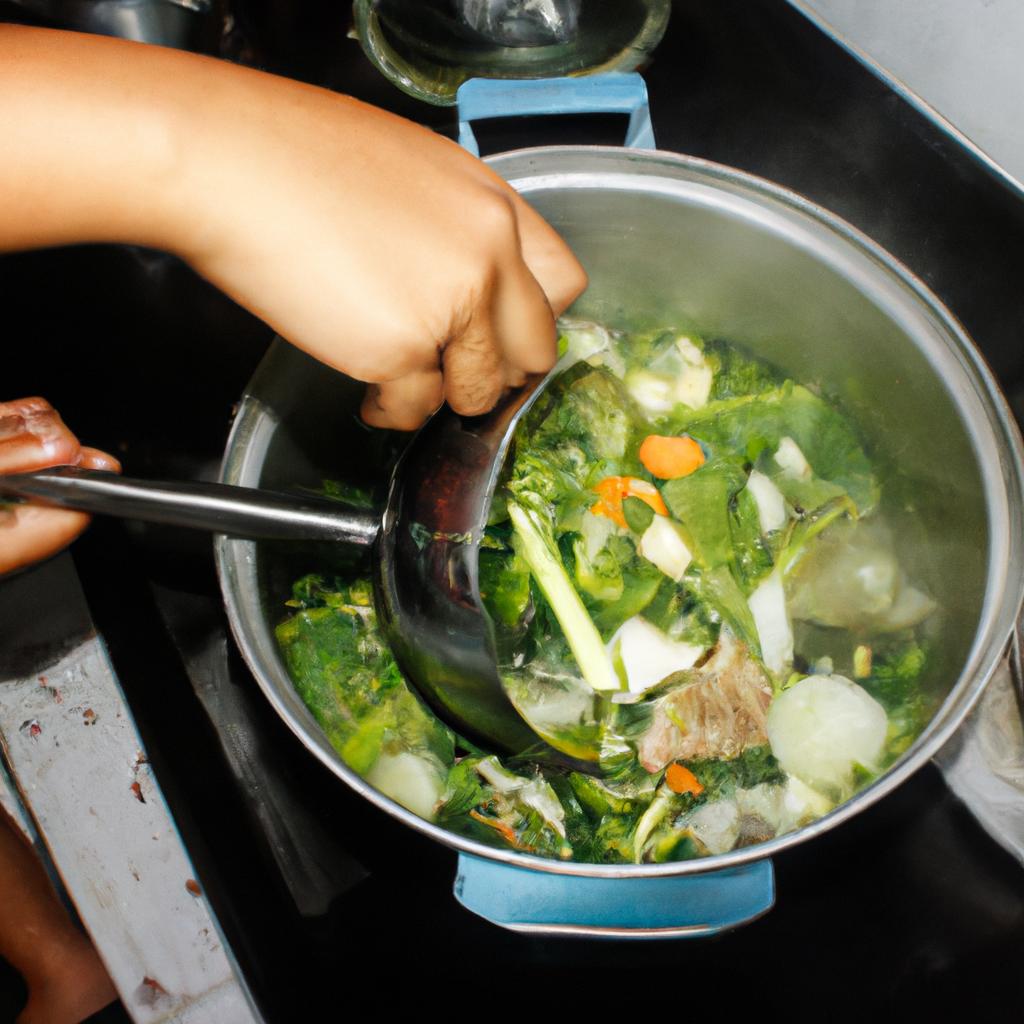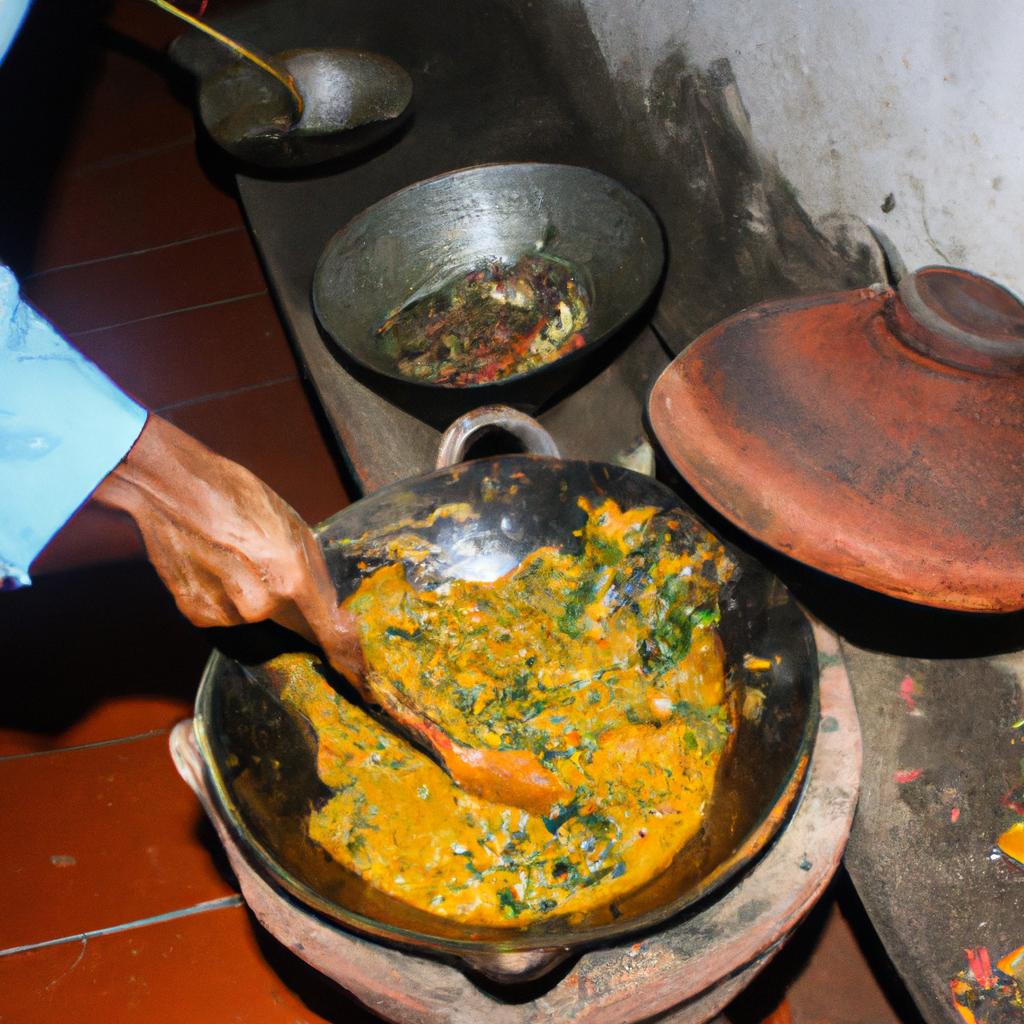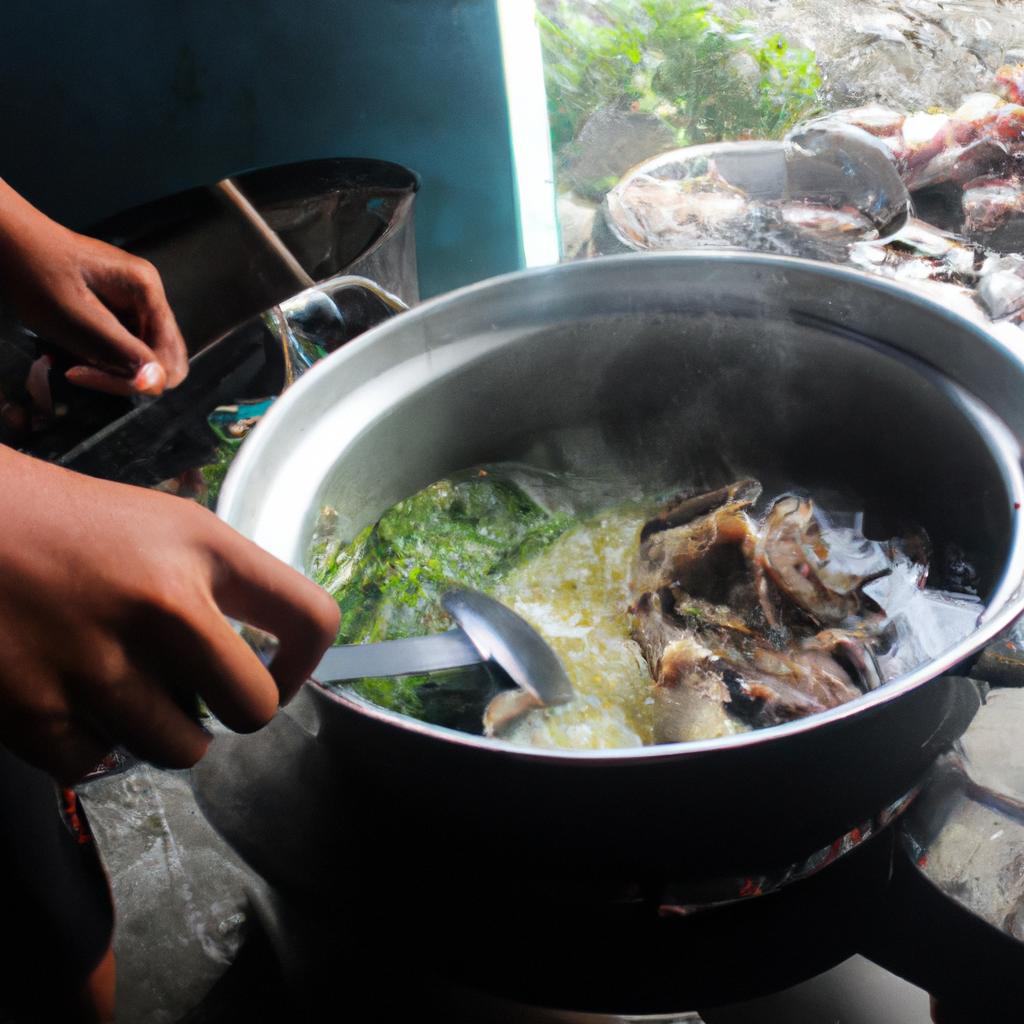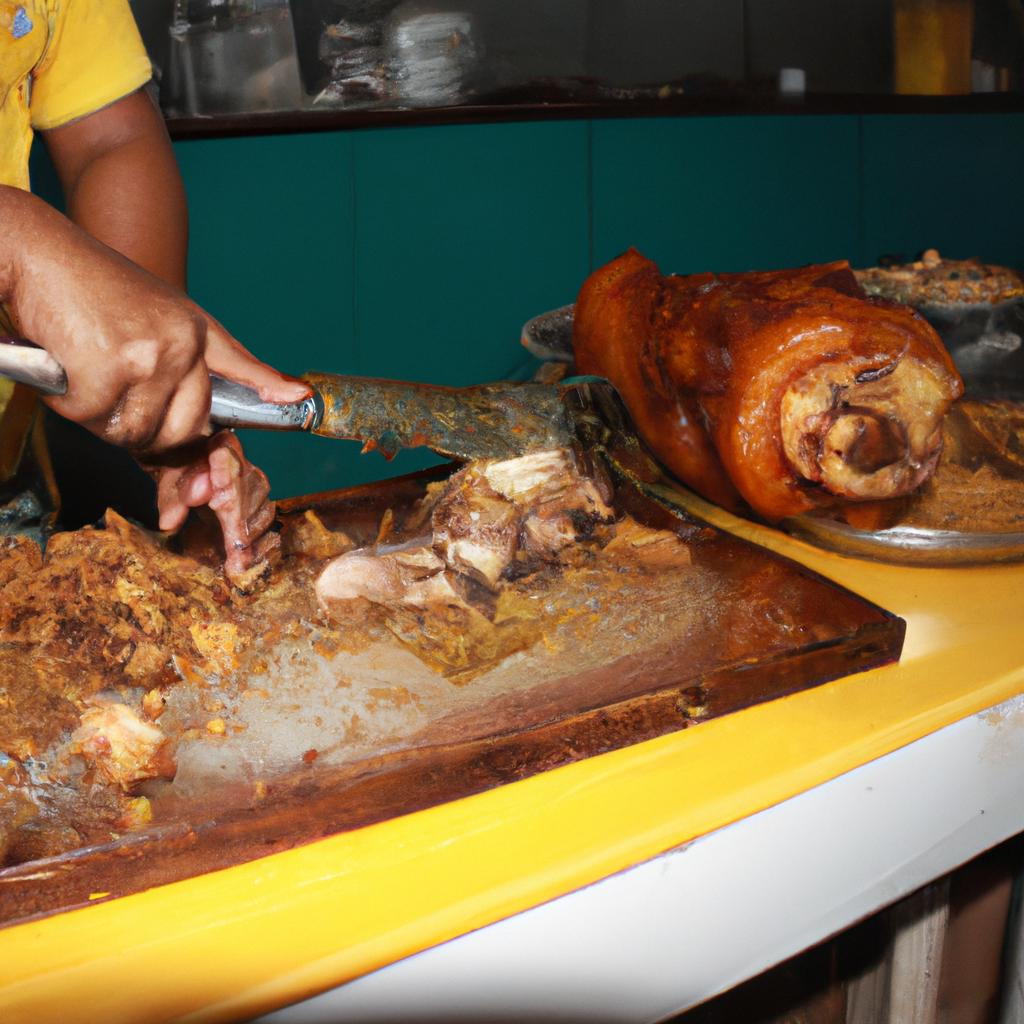Sinigang, a traditional Filipino soup dish, has gained popularity both in the Philippines and abroad. This unique dish is known for its sour taste, which is achieved by using tamarind or other souring agents as the main flavoring ingredient. Sinigang can be made with various types of meat such as pork, beef, shrimp, or fish, and it is typically cooked with an assortment of vegetables like kangkong (water spinach), radish, tomatoes, and string beans. One example that demonstrates the widespread appeal of sinigang is its inclusion in the menu of a renowned Filipino restaurant chain in New York City. Despite being thousands of miles away from its country of origin, this humble soup has captivated the palates of people from different cultural backgrounds.
The origins of sinigang can be traced back to pre-colonial times when Filipinos utilized available ingredients to create flavorful dishes. Over time, sinigang evolved into a beloved staple in Filipino cuisine due to its simplicity yet robust flavors. The combination of savory meat broth infused with tangy tamarind creates a harmonious balance that delights the senses. As sinigang continues to gain recognition worldwide, many have come to appreciate not only its distinctive taste but also its but also its versatility. Sinigang can be easily customized to suit different taste preferences and dietary restrictions. For instance, vegetarians can enjoy a meat-free sinigang by using tofu or mushrooms as a protein substitute. Additionally, sinigang can be made with a variety of vegetables, allowing for endless combinations and variations. Whether it’s a comforting bowl of pork sinigang on a rainy day or a refreshing seafood sinigang during hot summer months, this dish has the ability to adapt and satisfy diverse palates.
Moreover, sinigang is not just a delicious soup; it also holds cultural significance for Filipinos. It is often served during family gatherings, special occasions, and even ordinary meals at home. The act of sharing a steaming pot of sinigang signifies warmth, hospitality, and the strong bond within Filipino communities.
In conclusion, the widespread appeal of sinigang can be attributed to its sour yet savory flavor profile, its adaptability to various ingredients and dietary preferences, and its cultural significance in Filipino cuisine. Whether enjoyed in the Philippines or abroad, this humble soup continues to captivate hearts and taste buds alike.
Origin of Sinigang
Origin of Sinigang
Imagine sitting down at a Filipino restaurant, browsing through the menu, and coming across a dish called sinigang. The name itself might sound unfamiliar to you, but as soon as the waiter brings out a steaming bowl filled with an assortment of vegetables and tender meat swimming in a tangy broth, your curiosity is piqued. Where did this delicious soup come from? Let’s explore the origin of sinigang.
Sinigang can be traced back to pre-colonial times in the Philippines when early settlers used souring agents like tamarind, kamias (bilimbi), or guava to enhance the flavor of their dishes. Over time, these ingredients were combined with various meats such as pork, beef, fish, or shrimp to create sinigang’s distinctive taste profile. This beloved Filipino soup has become deeply ingrained in the country’s culinary culture and holds a special place on dining tables throughout the archipelago.
To understand the cultural significance of sinigang further, let us delve into its emotional appeal:
- Nostalgia: Sinigang often evokes memories of home-cooked meals shared with loved ones, bringing about feelings of comfort and warmth.
- Comfort food: It serves as a comforting remedy during rainy days or whenever one craves something hearty yet refreshing.
- Connection to nature: The use of locally sourced ingredients establishes a connection between consumers and their natural surroundings.
- Culinary heritage: Sinigang showcases traditional cooking methods that have been passed down through generations, preserving Philippine culinary traditions.
To summarize our exploration into sinigang’s origins and emotional appeal:
| Nostalgia | Comfort Food | Connection to Nature | Culinary Heritage |
|---|---|---|---|
| Memories of home-cooked meals | A comforting remedy | Locally sourced ingredients | Traditional cooking methods |
This first section has provided an introduction to the origin of sinigang, highlighting its historical roots and emotional significance. In the subsequent section about “Ingredients used in Sinigang,” we will delve deeper into the key components that give this soup its distinct flavor and character.
Ingredients used in Sinigang
From its humble beginnings as a traditional Filipino dish, sinigang has gained immense popularity both in the Philippines and around the world. Its unique blend of flavors and comforting qualities have made it a staple in many households and restaurants alike. Let’s explore the various reasons why sinigang has become such a beloved soup dish.
To illustrate the widespread appeal of sinigang, consider this hypothetical scenario: A group of friends from different cultural backgrounds gathers for dinner. They are presented with an array of dishes to choose from, including sinigang. Despite their diverse palates, they unanimously select the tangy and savory soup over other options. This example demonstrates how sinigang transcends cultural boundaries and captivates taste buds regardless of one’s culinary background.
One reason behind sinigang’s popularity lies in its versatility. The basic ingredients used in making sinigang can be customized according to personal preferences or dietary restrictions. Whether it is selecting between pork, beef, shrimp, fish, or even vegetarian options like tofu, there is a version of sinigang that suits everyone’s needs.
Moreover, the health benefits associated with consuming sinigang also contribute to its growing popularity. Packed with nutrient-rich vegetables such as kangkong (water spinach), okra, tomatoes, and radishes among others, sinigang offers a wholesome dining experience while providing essential vitamins and minerals.
- Sinigang brings people together by offering them a shared experience of comfort and nostalgia.
- The aroma wafting from simmering pots evokes feelings of warmth and anticipation.
- Each spoonful of flavorful broth provides solace during cold weather or when feeling under the weather.
- The act of slurping on hot soup fosters a sense of coziness and well-being.
As we delve further into exploring the various aspects of sinigang, it is worth noting the cultural significance attached to this beloved dish. Its presence during family gatherings and celebrations creates a sense of tradition and unity among Filipinos. Sinigang has become more than just a culinary delight; it represents cherished memories and an enduring connection to one’s heritage.
Transitioning into the subsequent section about “Variations of Sinigang,” we discover that even within the boundaries of this quintessential Filipino soup, there exists a vibrant world of creativity and experimentation.
Variations of Sinigang
Transition from the previous section:
Having discussed the various ingredients used in Sinigang, let us now explore the delightful variations of this beloved Filipino soup dish.
Variations of Sinigang
To illustrate the versatility of Sinigang, consider a hypothetical scenario where three friends decide to make Sinigang together. Each friend has their own preferences and culinary expertise, resulting in three distinct versions of the popular soup:
-
Seafood Medley Sinigang: Sarah, an avid seafood lover, opts for a medley of shrimp, clams, and fish as her main ingredients. This variation highlights the natural sweetness of seafood combined with the tangy flavors of tamarind broth.
-
Pork Ribs Sinigang: James enjoys the heartiness that pork ribs bring to any dish. He chooses tender pork ribs simmered with vegetables such as taro roots, string beans, and spinach. The rich flavor profile created by slow-cooking the pork bones adds depth to this version.
-
Vegetable Sinigang: Lisa prefers a vegetarian option without compromising on taste or nutritional value. She selects a combination of fresh vegetables like okra, eggplant, radishes, and water spinach (kangkong). The result is a vibrant and refreshing sinigang that showcases the natural goodness found in plant-based ingredients.
These examples demonstrate how diverse interpretations can yield equally delicious outcomes when it comes to crafting satisfying sinigang dishes.
Now let’s take a closer look at some key elements that contribute to this remarkable variety:
- Regional influences: Different regions within the Philippines often incorporate local produce or specialty ingredients into their versions of sinigang.
- Personal preferences: Individuals may choose different proteins or vegetables based on their dietary choices or personal tastes.
- Cultural adaptations: Some families have passed down unique recipes through generations, incorporating specific spices or techniques that reflect their cultural heritage.
- Seasonal variations: Depending on the availability of ingredients during different times of the year, sinigang can be adapted to incorporate seasonal produce for optimal freshness and flavor.
By embracing these diverse approaches, Sinigang has become a versatile dish that caters to various palates and dietary needs. Its ability to adapt and evolve over time makes it an enduring favorite among Filipinos both at home and abroad.
Moving forward, let us now delve into the health benefits that Sinigang offers, highlighting its nutritious qualities alongside its culinary appeal.
[Health benefits of Sinigang]
Health benefits of Sinigang
Sinigang, the beloved Filipino soup dish, comes in various forms and flavors. One popular variation is Sinampalukang Manok, which replaces tamarind with young sampaloc leaves to achieve a tangy taste. To illustrate the diversity of Sinigang, let’s explore some other noteworthy variations.
Firstly, there is Sinigang na Baboy sa Bayabas, where ripe guava is used as a souring agent instead of tamarind. This unique twist infuses the broth with a delightful sweetness that beautifully complements the savory pork chunks. Additionally, one can find seafood versions such as Sinigang na Hipon (shrimp) or Sinigang na Isda (fish). These iterations offer a lighter yet equally flavorful experience for those who prefer marine delicacies.
Now, let’s delve into the emotional connection people have with this iconic dish by highlighting its key characteristics:
- Comfort: The steaming bowl of sinigang provides warmth and comfort on rainy days.
- Nostalgia: It evokes memories of family gatherings and shared meals that bring loved ones closer together.
- Balance: The combination of sourness from tamarind or other fruits and vegetables creates a harmonious blend of flavors.
- Versatility: With numerous protein options and different souring agents available, sinigang adapts to individual preferences while maintaining its essence.
To further exemplify the breadth of choices within this culinary tradition, consider the following table showcasing popular types of meat typically used in sinigang:
| Protein | Description | Flavor Profile |
|---|---|---|
| Pork | Adds richness and depth to the broth | Savory |
| Beef | Provides an earthy flavor | Robust |
| Chicken | Offers a light alternative | Delicate |
| Seafood | Brings a delicate and fresh taste | Umami |
In summary, Sinigang’s versatility extends beyond its various forms to the emotional connections it fosters. Whether seeking comfort or looking to reminisce about cherished moments, this beloved Filipino soup dish never fails to deliver. Next, we will explore traditional methods of cooking sinigang, delving into the techniques that have been passed down through generations.
Traditional methods of cooking Sinigang
Imagine a scenario where you have invited some friends over for dinner. As you gather around the table, ready to indulge in the flavors of Filipino cuisine, one dish stands out among the rest – Sinigang. This popular Filipino soup dish has made its way into the hearts and taste buds of many due to its unique combination of sourness and savory flavors.
When it comes to cooking Sinigang, there are various methods that can be employed, each offering a slightly different twist on this beloved dish. Let’s explore some of these cooking variations:
-
Regional Differences:
- In different regions of the Philippines, ingredients may vary based on availability and local preferences.
- For example, in Southern Luzon and Visayas, guava is commonly used as the souring agent instead of tamarind or calamansi found in other parts of the country.
-
Protein Choices:
- While pork ribs are traditionally used in Sinigang, seafood such as shrimp or fish can also be incorporated for a delightful twist.
- Alternatively, if you prefer a vegetarian option, tofu or mixed vegetables can serve as excellent substitutes without compromising flavor.
-
Souring Agents:
- Tamarind is typically used to achieve the signature tangy taste in Sinigang; however, other souring agents like kamias (bilimbi), santol (cotton fruit), or even green mangoes can be utilized for a unique variation.
-
Broth Variations:
- The base broth for Sinigang often consists of water along with meat bones or head; however, some recipes call for adding pre-made mixes or bouillon cubes to enhance convenience without sacrificing taste.
By exploring these various cooking variations, you can customize your Sinigang experience according to personal preference or regional influences. Whether it’s opting for seafood instead of pork ribs or experimenting with different souring agents, the possibilities are endless.
As we delve into the next section about popular accompaniments for Sinigang, you’ll discover how these variations pair perfectly with certain side dishes and condiments. So let’s further explore this culinary journey together!
Popular accompaniments for Sinigang
Having explored the traditional methods of cooking sinigang, it is now essential to delve into the popular accompaniments that elevate this beloved Filipino soup dish. To better understand these complementing elements, let us consider a hypothetical case study of a family gathering where sinigang takes center stage.
Accompaniments That Enhance the Sinigang Experience:
To enhance the overall experience and flavor profile of sinigang, various accompaniments are commonly enjoyed alongside this classic dish. These additions not only provide contrasting textures but also infuse unique flavors that harmonize with the tangy broth. Some notable examples include:
- Steamed white rice: A staple in Filipino cuisine, steamed white rice serves as a neutral base that helps balance out the sourness of sinigang’s broth.
- Fish sauce or patis: Known for its savory umami taste, fish sauce adds depth and complexity to the sinigang’s flavors when drizzled sparingly over your bowl.
- Fresh calamansi juice: Extracted from local citrus fruits called calamansi, this acidic juice enhances the brightness and zinginess of each spoonful of sinigang.
- Chili peppers: For those who enjoy a spicy kick, adding chili peppers (siling labuyo) can lend an extra layer of heat and excitement to every bite.
The delectable combination of tender meat or seafood simmered in a flavorful broth along with these enticing accompaniments creates an emotional connection between Filipinos and their beloved sinigang. Here are four reasons why many find themselves drawn to this hearty soup:
- Nostalgia-inducing aroma that evokes childhood memories
- Comforting warmth during rainy days or chilly evenings
- Shared joy and camaraderie during family gatherings or celebrations
- A symbol of Filipino culinary heritage, fostering cultural pride
Emotional Table:
| Accompaniment | Flavor Enhancement | Emotional Connection |
|---|---|---|
| Steamed white rice | Balances sourness | Brings a sense of familiarity |
| Fish sauce (patis) | Adds umami complexity | Reminiscent of home-cooked meals |
| Fresh calamansi juice | Enhances brightness | Elicits a refreshing sensation |
| Chili peppers | Provides spicy kick | Ignites excitement and passion |
Incorporating these accompaniments into the sinigang experience helps to create an emotional connection that goes beyond mere sustenance. As Filipinos gather around the table and partake in this beloved dish, they are reminded of cherished memories, find solace in its comforting embrace, and celebrate their shared culture.
This exploration into popular accompaniments demonstrates how sinigang has become more than just a soup; it is a representation of Filipino identity and serves as a medium for strengthening familial bonds. It is through these diverse elements that sinigang continues to captivate both locals and foreigners alike, leaving them craving another spoonful of this iconic Filipino delicacy.

